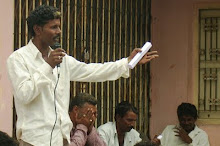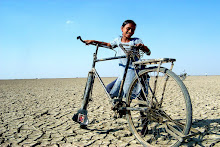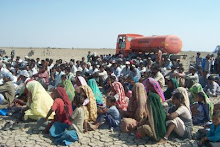Counterview: Ahmedabad: Friday, 29th Dec 2023.
Agariyas of the Santalpur block of Patan district, Gujarat, have not been allowed to enter the Little Rann of Kutch (LRK) for salt farming since September 2023. After repeated representations at the Principal Chief Conservator of Forests' (PCCF's) office, Agariyas reached the Patan district collector to announce that they were going to protest against the “discrimination” done by the forest department.
Reacting to the Counterview story that 1,200 Agariyas are not being allowed to enter LRK in specific areas, PCCF (wild life) Nityanand Srivastava said, “We are allowing only those whose name are there in the settlement report”, though underlining, only those “eligible for one well” will be permitted to do salt farming. This is necessitated, he added, by the fact that in earlier years, it was noticed, people employed by non-salt farming sections “were doing salt farming not as a means of earning but as a business of others”, with many working on “10 to 15 wells”.
Salt cultivation with one well is possible for up to 10 acres of land.
The process of the Survey and Settlement Report, prepared in the wake of a World Bank conditionality for grant to conserve biodiversity of the LRK’s wild ass sanctuary, was initiated in September 1997 and ended in 2016. Said to be an incomplete survey, it identified only 189 Agariyas to be included in the list for Santalpur block, as against estimates of up to 1,200.
A large number of Agariyas were left out from the survey as they were asked to produce ownership documents, which traditional Agariyas do not possess, say activists.
“There are lots of gaps in the Survey and Settlement Report”, believes Harinesh Pandya of the Agariya Heet Rakshak Manch (AHRM). “LRK is largely an un-surveyed piece of land. It was identified as survey number zero in 2006. Ironically, the government does not have revenue record of LRK”.
Importantly, the expert committee formed by the Government of India in 1948 clearly mentions that small Agariyas (up to 10-acre of land) do not require any registration or permission or license. This issue was recognized by even the chief minister’s office in 2008, and directions were given that “suo moto camps should be held to taking into account the Agariyas' claims.”
Large number of Agariyas were not even aware of the Survey and Settlement process when it was supposedly carried out.
“This is one reason why, on 4th September 2023, it was decided that the Survey and Settlement Report would need to be revised after having ‘on-site’ surveys”, Pandya underlined.
Agariyas of the Santalpur block of Patan district, Gujarat, have not been allowed to enter the Little Rann of Kutch (LRK) for salt farming since September 2023. After repeated representations at the Principal Chief Conservator of Forests' (PCCF's) office, Agariyas reached the Patan district collector to announce that they were going to protest against the “discrimination” done by the forest department.
Reacting to the Counterview story that 1,200 Agariyas are not being allowed to enter LRK in specific areas, PCCF (wild life) Nityanand Srivastava said, “We are allowing only those whose name are there in the settlement report”, though underlining, only those “eligible for one well” will be permitted to do salt farming. This is necessitated, he added, by the fact that in earlier years, it was noticed, people employed by non-salt farming sections “were doing salt farming not as a means of earning but as a business of others”, with many working on “10 to 15 wells”.
Salt cultivation with one well is possible for up to 10 acres of land.
The process of the Survey and Settlement Report, prepared in the wake of a World Bank conditionality for grant to conserve biodiversity of the LRK’s wild ass sanctuary, was initiated in September 1997 and ended in 2016. Said to be an incomplete survey, it identified only 189 Agariyas to be included in the list for Santalpur block, as against estimates of up to 1,200.
A large number of Agariyas were left out from the survey as they were asked to produce ownership documents, which traditional Agariyas do not possess, say activists.
“There are lots of gaps in the Survey and Settlement Report”, believes Harinesh Pandya of the Agariya Heet Rakshak Manch (AHRM). “LRK is largely an un-surveyed piece of land. It was identified as survey number zero in 2006. Ironically, the government does not have revenue record of LRK”.
Importantly, the expert committee formed by the Government of India in 1948 clearly mentions that small Agariyas (up to 10-acre of land) do not require any registration or permission or license. This issue was recognized by even the chief minister’s office in 2008, and directions were given that “suo moto camps should be held to taking into account the Agariyas' claims.”
Large number of Agariyas were not even aware of the Survey and Settlement process when it was supposedly carried out.
“This is one reason why, on 4th September 2023, it was decided that the Survey and Settlement Report would need to be revised after having ‘on-site’ surveys”, Pandya underlined.
















.jpg)
.jpg)
.jpg)
.jpg)













No comments:
Post a Comment